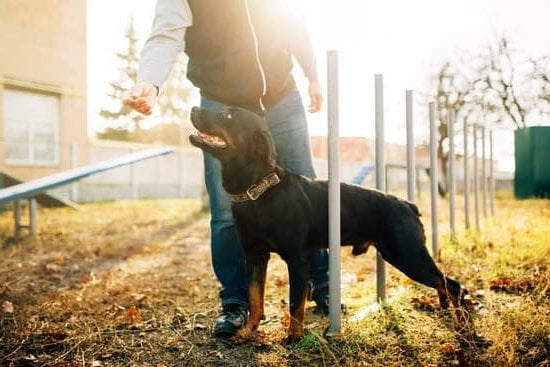Labradoodles are highly regarded for their intelligence, trainability, and friendly nature, making them excellent candidates for service dog work. In this article, we will explore how to train a Labradoodle to be a service dog. Service dogs play a crucial role in assisting individuals with disabilities or medical conditions, providing them with support and independence in their daily lives.
Labradoodles, a crossbreed between Labrador Retrievers and Poodles, possess the desirable qualities of both breeds, such as loyalty, non-shedding coats, and high energy levels. These characteristics make them well-suited for various types of service work, including guiding the visually impaired, alerting to medical emergencies, and providing emotional support.
Selecting the right Labradoodle candidate for service dog training is essential to ensure success. Factors such as temperament, health history, and compatibility with the handler’s needs must be carefully considered. By understanding the unique characteristics of Labradoodles and implementing effective training techniques, you can prepare your furry companion for a fulfilling career as a service dog.
Understanding the Characteristics of Labradoodles
Labradoodles are a popular choice for service dog training due to their intelligence, friendly disposition, and hypoallergenic coat. Understanding the specific characteristics of Labradoodles is essential in successfully training them to be reliable service dogs. Here are some key traits of Labradoodles to consider:
- Intelligent: Labradoodles are known for their high intelligence, making them quick learners during training sessions.
- Friendly and Sociable: These dogs have a friendly and sociable nature, which is crucial for interacting with different people in various environments as service dogs.
- Energetic: Labradoodles have a good amount of energy, requiring regular exercise and mental stimulation to keep them happy and focused on their tasks.
To effectively train a Labradoodle to be a service dog, it is important to take into account these characteristics and tailor the training program accordingly. With the right approach and techniques, you can help your Labradoodle reach its full potential as a reliable service companion.
When learning how to train a Labradoodle to be a service dog, keep in mind that each dog is unique and may require individualized training methods. By understanding the specific traits of Labradoodles and adapting your training techniques accordingly, you can set your furry friend up for success in fulfilling its role as a service dog. Remember patience, consistency, and positive reinforcement are key elements in the training process.
Choosing the Right Labradoodle for Service Dog Training
Labradoodles are known for their intelligence, friendliness, and versatility, making them an excellent choice for service dog training. When selecting a Labradoodle for this important role, it is crucial to consider various factors to ensure the success of the training process.
One of the key aspects to look for in a potential service dog candidate is their temperament. Labradoodles should exhibit traits such as calmness, attentiveness, and a willingness to please in order to be successful in assisting individuals with disabilities.
Health and Genetic Considerations
In addition to temperament, it is essential to focus on the health and genetic background of the Labradoodle being considered for service dog training. Health issues can impact a dog’s ability to perform tasks effectively and may also affect their overall well-being. Conducting thorough health screenings and ensuring that the Labradoodle comes from responsible breeders who prioritize health can help prevent potential issues in the future.
Evaluation by Professional Trainers
Before officially embarking on service dog training, it is advisable to have the selected Labradoodle evaluated by professional trainers or organizations specializing in service dog work. These experts can assess whether the dog possesses the necessary qualities and aptitude for performing tasks effectively.
Their evaluation can provide valuable insights into whether the Labradoodle has what it takes to excel as a service dog. Through a comprehensive assessment, trainers can determine if additional training or adjustments are needed before proceeding with formal training programs.
By carefully considering temperament, health factors, and seeking professional evaluations, individuals can make informed decisions when choosing a Labradoodle for service dog training. Selecting the right candidate lays a solid foundation for successful training outcomes and paves the way for creating a reliable companion that can positively impact the lives of individuals in need.
Essential Commands and Skills for Service Dogs
Labradoodles, with their intelligence and friendly nature, make excellent candidates for service dog training. To train a Labradoodle to be a service dog, it is crucial to start with teaching them essential commands and skills that are necessary for their role. Some of the key commands include “sit,” “stay,” “heel,” “come,” and “down.” These basic commands form the foundation upon which more specialized tasks can be built.
In addition to basic commands, service dogs need to learn specialized skills based on the specific needs of their handler. For example, a service dog for someone with mobility issues may need to learn how to retrieve items, open doors, or provide balance support. On the other hand, a psychiatric service dog may need to learn tasks such as grounding techniques or interrupting self-harming behaviors.
Training a Labradoodle to perform these essential commands and skills requires patience, consistency, and positive reinforcement. Positive reinforcement training involves rewarding the dog for correct behaviors with treats, praise, or playtime.
This method not only helps in building a strong bond between the dog and its handler but also makes learning enjoyable for the Labradoodle. It is important to remember that each dog learns at its own pace, so being patient and understanding throughout the training process is key to success.
| Labradoodle Training Tips | Benefits |
|---|---|
| Use positive reinforcement | Strengthens bond between dog and handler |
| Be consistent with commands | Helps in quicker learning and retention |
| Practice regular socialization | Makes the dog comfortable in various environments |
Positive Reinforcement Training Techniques for Labradoodles
Labradoodles, like other breeds, respond well to positive reinforcement training techniques. This method focuses on rewarding desired behaviors rather than punishing unwanted ones. When it comes to training a Labradoodle to be a service dog, using positive reinforcement is key in building a strong bond and trust between the dog and handler. Positive reinforcement can include treats, praise, toys, or any other reward that motivates the Labradoodle.
Clicker Training
One effective positive reinforcement technique for training Labradoodles is clicker training. A clicker is a small device that makes a distinctive clicking sound when pressed. The idea is to associate this sound with a reward, signaling to the dog that they have performed the correct behavior. Clicker training can be used to teach new commands, shape behaviors, and reinforce good manners in service dog candidates.
Marker Training
Marker training is another form of positive reinforcement that involves using a verbal marker (e.g. “yes” or “good”) to indicate the exact moment your Labradoodle has done something right. By pairing this marker with a reward immediately after the desired behavior occurs, you are helping your service dog-in-training understand what you are asking of them. Consistency and timing are crucial in marker training to effectively communicate with your Labradoodle during their service dog education.
By utilizing positive reinforcement techniques such as clicker and marker training, you can effectively train your Labradoodle to be a successful service dog. Remember to stay patient, consistent, and make training sessions fun for both you and your furry companion. With dedication and the right approach, your Labradoodle will be well on their way to becoming a reliable and responsive service animal.
Socialization and Public Access Training for Service Dogs
Labradoodles are known for their intelligence, friendly nature, and versatility, making them excellent candidates for service dog training. Socialization and public access training are crucial aspects of preparing a labradoodle to become a reliable service dog. Socialization involves exposing the dog to various environments, people, and animals to ensure they can confidently navigate the world around them. Public access training focuses on teaching the dog how to behave appropriately in different public settings, such as restaurants, shops, and public transportation.
One of the key techniques in socialization and public access training is desensitization. This involves gradually introducing the labradoodle to different stimuli in a controlled manner to reduce fear or anxiety responses.
For example, starting with low-stress environments and progressively increasing the level of distraction can help the dog build confidence and remain calm in challenging situations. Positive reinforcement is also essential during this process – rewarding desired behaviors such as greeting strangers politely or staying focused amidst distractions will motivate the labradoodle to continue exhibiting good behavior.
In addition to basic obedience commands, a service dog must learn specific tasks related to their handler’s needs. This could include retrieving items, opening doors, providing balance support, or alerting to medical conditions.
Socialization and public access training play a vital role in ensuring that the labradoodle can perform these tasks reliably in any situation. By following structured training plans and using positive reinforcement techniques consistently, handlers can effectively prepare their labradoodles for the responsibilities of being a service dog.
| Labradoodle Training Techniques | Socialization Tips |
|---|---|
| Desensitization and gradual exposure to stimuli | Start with low-stress environments |
| Positive reinforcement for desired behaviors | Reward polite greetings with strangers |
Tasks and Responsibilities of a Service Dog
Labradoodles, like many other breeds, can make excellent service dogs with the right training and guidance. These intelligent and loyal dogs are known for their friendly nature and versatility, which makes them well-suited for a variety of service dog roles. As a service dog, a Labradoodle’s tasks and responsibilities can vary depending on the individual’s needs, but they often include tasks such as providing physical assistance, alerting to medical conditions, or offering emotional support.
When training a Labradoodle to be a service dog, it is essential to focus on teaching them specific tasks that will assist their handler in their everyday life. Some common tasks include retrieving items, opening doors, turning on lights, or even detecting changes in blood sugar levels for individuals with diabetes.
It is crucial to start with basic obedience training before moving on to more advanced tasks. Below are some essential tasks and responsibilities that a service dog may be trained to perform:
- Alerting to sounds such as doorbells or alarms
- Guiding the handler safely through crowds or obstacles
- Providing deep pressure therapy for individuals with anxiety disorders
- Assisting with mobility by providing balance support or stability
- Responding to medical emergencies by fetching help or medication
In addition to specific tasks, service dogs also have the responsibility of being well-behaved and obedient in all situations. They must be able to focus on their handler’s needs while remaining calm and attentive in various environments.
It is important for handlers to continuously reinforce their Labradoodle’s training through practice sessions and positive reinforcement. With consistency and patience, a Labradoodle can fulfill their duties effectively as a service dog while providing invaluable assistance and companionship to their handler.
Handling Challenges and Setbacks in Training
Training a Labradoodle to be a service dog can be a rewarding but challenging journey. Like any other training process, it is common to encounter setbacks and challenges along the way. It is important to remember that every dog is unique, and what works for one may not work for another. Being patient, persistent, and adaptable are key qualities when faced with obstacles in training your Labradoodle.
One common challenge in training a service dog is overcoming behavioral issues such as fear, anxiety, or aggression. These issues can hinder the dog’s ability to perform tasks or remain focused in public settings. It is crucial to address these behavior problems with the help of a professional trainer or behaviorist who has experience working with service dogs. By identifying the root cause of the behavior and implementing appropriate strategies, you can help your Labradoodle overcome these challenges.
Another challenge that handlers may face is maintaining motivation and consistency throughout the training process. Training a service dog requires dedication and commitment on both ends – from the handler and the dog. It is important to set realistic goals, break down tasks into manageable steps, and celebrate small victories along the way.
Consistency in commands, routines, and reinforcement techniques is essential for your Labradoodle to grasp the skills needed to become an effective service dog. Remember that perseverance and positivity go a long way in overcoming challenges during training.
Certification and Legal Considerations for Service Dogs
When training a Labradoodle to be a service dog, it is essential to understand the certification and legal considerations involved in this process. In order for your Labradoodle to be recognized as a service dog, they must meet specific training standards and pass certification tests.
It is important to note that there is no official government-mandated certification for service dogs in the United States. However, many organizations offer voluntary certification programs that can help validate your Labradoodle’s training and skills.
One key factor to consider when certifying your Labradoodle as a service dog is the Americans with Disabilities Act (ADA) regulations. According to the ADA, service dogs are defined as dogs that are individually trained to perform tasks for people with disabilities.
These tasks can include but are not limited to guiding individuals who are blind, alerting individuals who are deaf, pulling wheelchairs, and alerting and protecting a person during a seizure. It is important that your Labradoodle is trained specifically to assist you with your disability if you want them to qualify as a service dog under the ADA.
In addition to meeting training standards, it is crucial to understand the legal rights and responsibilities associated with having a service dog. Service dogs are granted certain protections under the law, including access rights in public places such as restaurants, stores, hotels, and transportation vehicles.
It is important to educate yourself on these rights and ensure that your Labradoodle is trained not only to perform necessary tasks but also to behave appropriately in public settings. By understanding the certification process and legal considerations for service dogs, you can ensure that your Labradoodle is well-prepared to assist you effectively while complying with relevant regulations.
Resources and Support for Service Dog Training Success
In conclusion, training a Labradoodle to be a service dog can be a rewarding and fulfilling experience for both the dog and the trainer. By understanding the unique characteristics of Labradoodles, choosing the right candidate for service dog training, and focusing on essential commands and skills, you can set your furry companion up for success in their new role.
Positive reinforcement techniques, socialization, public access training, and patience are all key components in the journey of transforming your Labradoodle into a reliable service dog.
Furthermore, handling challenges and setbacks during training is important to stay focused on the end goal. It’s essential to be patient, consistent, and adaptable in your approach to ensure that your Labradoodle reaches their full potential as a service dog. Seeking certification and understanding legal considerations are also crucial steps towards solidifying your Labradoodle’s role as a service dog in various settings.
Lastly, having access to resources and support systems throughout the training process is invaluable. Whether it’s joining local training groups, seeking guidance from experienced trainers, or utilizing online tools and materials dedicated to service dog training, there are numerous avenues available to help you succeed in training your Labradoodle for this impactful role.
With dedication, patience, and the right support network in place, you can effectively train your Labradoodle to be a reliable and capable service dog ready to assist those in need.
Frequently Asked Questions
Can You Train a Labradoodle to Be a Service Dog?
Training a Labradoodle to be a service dog is definitely possible, as they are known for their intelligence and trainable temperament. Labradoodles can excel in tasks such as retrieving or providing emotional support to individuals with disabilities.
Do Labradoodles Make Good Therapy Dogs?
Labradoodles make excellent therapy dogs due to their friendly and sociable nature. They are known for being attentive, affectionate, and easily forming bonds with people. Their hypoallergenic coat also makes them suitable for therapy work.
What Breed Cannot Be a Service Dog?
There is no specific breed that cannot be a service dog, as any breed can potentially be trained to assist individuals with disabilities. However, breeds that have aggressive tendencies or are not suited for human interaction may not be ideal candidates for service dog work.
The most important factors are the individual dog’s temperament, willingness to learn, and ability to perform necessary tasks effectively.

Welcome to the blog! I am a professional dog trainer and have been working with dogs for many years. In this blog, I will be discussing various topics related to dog training, including tips, tricks, and advice. I hope you find this information helpful and informative. Thanks for reading!





